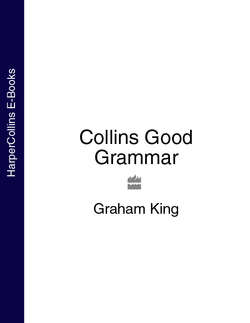Читать книгу Collins Good Grammar - Graham King - Страница 22
The Building Blocks of Sentences: Parts of Speech
ОглавлениеIn Victorian times, when life was simpler, so, apparently was grammar. Here is a little verse widely used to teach young children the parts of speech during the latter part of the 19th century:
Three little words we often see,
Determiners, like a, an and the.
A Noun’s the name of anything,
A school or garden, hoop or string.
An Adjective tells the kind of noun,
Like great, small, pretty, white or brown.
Instead of nouns the Pronouns stand –
John’s head, his face, my arm, your hand.
Verbs tell of something being done,
To read, write, count, sing, jump or run.
How things are done, the Adverbs tell,
Like slowly, quickly, ill or well.
A Preposition stands before
A noun, as in a room, or through a door.
Conjunctions join the nouns together,
Like boy or girl, wind and weather.
The Interjection shows surprise,
Like Oh! How charming. Ah! How wise!
The whole are called ‘Nine Parts of Speech’,
Which reading, writing and speaking teach.
For millions of Victorian children this rhyme served as a gentle introduction to the terrors of parsing – the art of analysing the various roles played by words in a sentence. Whether the terror was real or imagined no doubt depended upon how the subject was taught. For the majority of children it was probably never an easy business to grasp, and this went for the teachers, too, to the extent that for a quarter of a century from the 1960s it was the misguided fashion in many quarters not to teach it at all. As a result many millions of today’s adults in the English-speaking world have a big black hole in their grammatical education.
The fact that many words defy a single classification doesn’t make things easier. We have seen how the word round can play five different roles depending upon how it is used in a sentence. Many other words are similarly versatile: love can act as a noun, verb and adjective, and so can light; fast can play the roles of noun, verb, adjective and adverb, and so on. That can be used as an adjective and as a pronoun:
That jacket belongs to me. (adjective)
That is my jacket. (pronoun)
Words – especially neologisms, or newly-coined words – also have the confusing habit of migrating from one class to another:
The doctor observed the patient’s knee jerk. (noun / verb)
His speech produced the inevitable knee-jerk reaction. (adjective)
The President was a master of the art of the knee-jerk. (noun)
Not all words have this chameleon quality, however. All words can be divided into two broad classes: open classes (which freely admit new words) and closed classes (which rarely do). For example:
OPEN CLASSES
| Nouns | software, gazumper, Fergy, tummytuck, spin doctor |
| Adjectives | neural, digital, cellular, quaffable, hands-on |
| Verbs | outed, overdosed, stargaze, deselect, nuke |
| Adverbs | breezily, chaotically, totally, tackily |
| Interjections | Phew! aahhh, ouch! Phooorrh! |
CLOSED CLASSES
| Determiners | the, which, my, that, your, these |
| Pronouns | I, me, we, hers, someone, whom |
| Conjunctions | and, or, but, when, since, as |
| Prepositions | at, with, in, by, to, from |
| Auxiliaries | be, may, can, will, were, must |
You can see from these examples that the closed classes of words are more or less static; it is very difficult to create new determiners or substitutes for the, my and your. The open classes, however, are expanding all the time.
At this point a pause may be useful, because you are being confronted with grammatical terms which may mean little or nothing to you. But to make sense of grammar it is impossible to avoid familiarity with at least a handful of basic terms. These will, however, be kept to a workable and untaxing minimum.
Let’s begin with the ‘parts of speech’ – the components or building blocks of human communication. While you may not recognise the terms nor fully appreciate the roles they play, you are using them almost every minute of the day in your speech and writing. A simple analysis of a sentence might look like this:
If you’re ever in doubt about the grammatical status of any word, a good dictionary will tell you. Apart from defining a word’s meaning the entry will also identify its use as a noun (n), adjective (adj), adverb (adv) etc, and often give examples of usage.
What follows now is a brief outline of each of the nine classes into which all words are grouped according to their function. This is designed to help you find your feet on the nursery slopes of the grammatical piste. A more detailed discussion on each word class follows.
